Avro Anson
The Avro Anson is a British twin-engined, multi-role aircraft built by the aircraft manufacturer Avro. Large numbers of the type served in a variety of roles for the Royal Air Force (RAF), Fleet Air Arm (FAA), Royal Canadian Air Force (RCAF) and numerous other air forces before, during, and after the Second World War.
| Anson | |
|---|---|
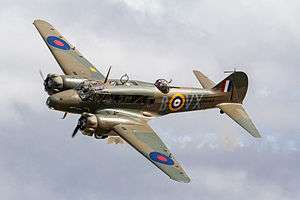 | |
| Avro Anson ZK-RRA in flight, Classic Fighters Airshow (2015) | |
| Role | Multirole aircraft, primarily a trainer |
| National origin | United Kingdom |
| Manufacturer | Avro |
| First flight | 24 March 1935 |
| Introduction | 1936 |
| Retired | 28 June 1968 (RAF) |
| Status | One flying, otherwise retired. |
| Primary users | Royal Air Force Fleet Air Arm Royal Canadian Air Force Royal Australian Air Force |
| Produced | 1930s–1952 |
| Number built | 11,020 |
| Developed from | Avro 652 |
Initially known as the Avro 652A, the Anson was developed during the mid-1930s from the earlier Avro 652 airliner in response to a request for tenders issued by the British Air Ministry for a maritime reconnaissance aircraft. Having suitably impressed the Ministry, a single prototype was ordered, which conducted its maiden flight on 24 March 1935. Following an evaluation in which the Type 652A bettered the competing de Havilland DH.89, it was selected as the winner, leading to Air Ministry Specification 18/35 being written around the type and an initial order for 174 aircraft being ordered in July 1935. The Type 652A was promptly named after British Admiral George Anson.
The type was placed into service with the Royal Air Force (RAF) and was initially used in the envisioned maritime reconnaissance operation alongside the larger flying boats. After the outbreak of the Second World War the Anson was soon found to have become obsolete in front line combat roles. Large numbers of the type were instead put to use as a multi-engined aircrew trainer, having been found to be suitable for the role, and became the mainstay of the British Commonwealth Air Training Plan. The type continued to be used in this role throughout and after the conflict, remaining in RAF service as a trainer and communications aircraft until 28 June 1968.
During the post-war climate, the Anson was increasingly produced for the civil market, being used as a light transport and executive aircraft. By the end of production in 1952, a total of 8,138 Ansons had been constructed by Avro in nine variants; in addition, a further 2,882 aircraft were manufactured by Federal Aircraft Ltd in Canada from 1941. By the 21st century, the vast majority of Ansons had been retired from flying. However, a single Anson Mk.I, which had been originally manufactured during 1943, had been restored to airworthiness, having been refitted with later metal wings. On 18 July 2012, this restored aircraft performed its first flight.
Development
In 1933, the British Air Ministry proposed that the Royal Air Force (RAF) acquire a relatively cheap landplane for coastal maritime reconnaissance duties; the proposed aircraft would perform as a supplement to the more capable, but expensive, flying boats which the RAF had adopted for conducting maritime reconnaissance missions. The Air Ministry requested tenders from major aircraft manufacturers to produce a suitable aircraft in order to meet this requirement. Avro decided to respond to the request with the Avro 652A, which was a modified version of the earlier Avro 652, a twin-engined, six-seat monoplane airliner. After evaluating the various submissions received, the Air Ministry decided to place a pair of orders, with Avro and de Havilland respectively, to manufacture single examples of the Type 652A and the de Havilland DH.89 for evaluation purposes in order to meet this requirement late in 1934; an evaluation and the subsequent selection of a design for production to take place by May 1935.[1][2]
On 24 March 1935, the Avro 652A conducted its maiden flight at Woodford Aerodrome, Greater Manchester. Between 11 and 17 May 1935, the prototype participated in a formal evaluation against the competing DH.89M by the RAF's Coastal Defence Development Unit at RAF Gosport, Hampshire. During these trials, the Avro aircraft proved to be superior and was accordingly selected as the winner of the competition on 25 May 1935.[3] In response to its selection, Air Ministry Specification 18/35 was written around the Type 652A; in July 1935, an initial order for 174 aircraft, which had been given the name "Anson", was received.[4]
On 31 December 1935, the first production Anson performed its maiden flight; changes from the prototype included an enlarged horizontal tailplane and reduced Elevator span in order to improve stability. Additionally, while the prototype had not been fitted with flaps, production aircraft could accommodate their installation from the onset to increase the viable glide angle and reduce landing speed.[5] On 6 March 1936, deliveries to the RAF commenced.[6] By the end of production in 1952, a total of 11,020 Ansons had been completed, which made it the second most numerous (after the Vickers Wellington) British multi-engined aircraft of the Second World War.[7]
Design
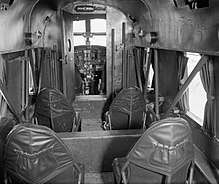
The Avro Anson was a twin-engine, low-wing cantilever monoplane. Developed as a general reconnaissance aircraft, it possessed many features that lent itself to the role, including considerable load-carrying ability, and long range.[8] The structure of the Anson was relatively straightforward and uncomplicated, relying on proven methods and robust construction to produce an airframe that minimised maintenance requirements.[8] Much of the internal structure had retained similar to the earlier Avro 652 airliner from which it had been developed. The Anson Mk I was furnished with a low-mounted one-piece wooden wing, composed of a combination of plywood and spruce throughout the wingbox and ribs. The fuselage was composed of a welded steel tubing framework which was principally clad in fabric; the exterior of the nose was clad in magnesium alloy.[8]
The Anson was powered by a pair of Armstrong Siddeley Cheetah IX seven-cylinder air-cooled radial engines, which were each rated at 350 horsepower (260 kW).[9][5] Each engine was provided with its own duplicated fuel pumps and separate fuel and oil tanks; the tanks were composed of welded aluminium and mounted in cradles housed within the wing. The engine cowling were intentionally designed to have a reduced diameter in order to reduce their negative impact upon external visibility, which was considered to be valuable to the type's reconnaissance function.[8] These engines each drove a set of two-bladed Fairey-built metal propellers.[5]
The Anson was equipped with a retractable undercarriage arrangement, which was uncommon upon its introduction; it holds the distinction of being the first aircraft to feature such an innovation to enter service with the RAF.[8][10] While the main undercarriage was retracted into recesses set into the bottom of the engine nacelles, the tail wheel was fixed in position. Commonly, the undercarriage was fitted with Dunlop-built wheels, tyres and pneumatic brakes and Turner legs.[5] The retractable undercarriage was mechanically operated by hand; 144 turns of a crank handle, situated besides the pilot's seat, were needed.[11][12] To avoid this laborious process, early aircraft would often perform short flights with the landing gear remaining extended throughout, which would reduce the aircraft's cruising speed by 30 mph (50 km/h).[7]
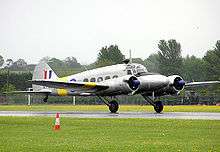
Initially, the Anson was flown with a three-man crew, which comprised a pilot, a navigator/bomb-aimer and a radio operator/gunner, when it was used in the maritime reconnaissance role;[13] from 1938 onwards, it was typically operated by a four-man crew.[14] The bomb-aimer would perform his function from a prone position in the forward section of the nose, which was provisioned with a bombsight, driftsight, and other appropriate instrumentation, including a landing light. The pilot was located in a cockpit behind the bomb-aimer's position and was provided with a variety of contemporary instrumentation, including those to enable flight under instrument flight rules (IFR) and indirect instrument lighting for night flying purposes.[15]
Immediately behind the pilot's position is a small folding seat fixed to the starboard side of the fuselage for an additional crew member or passenger, along with racks that would contain a pair of parachute packs that would be clipped onto the harnesses worn by both the pilot and the navigator. Behind these is the navigator's station, a chair and table provisioned with navigational aids such as compasses, Bigsworth chart boards, sea markers, calculators for course, wind and speed, a signalling lamp and float flares.[13] Aft of the rear spar is the wireless operator's station - a table with contemporary wireless equipment, including a winch for the trailing aerial, which was attached to the upper fuselage immediately behind the aircraft's cockpit.[13]
The defensive armaments of the Anson consisted of a single .303 in (7.7 mm) Vickers machine gun which was fixed within the forward fuselage and aimed by the pilot, while an Armstrong Whitworth-built manually operated gun turret located on the Anson's dorsal section was fitted with a single Lewis gun.[13] Additionally, up to 360 pounds (160 kg) of bombs, which could consist of a maximum of two 100 pounds (45 kg) and eight 20 pounds (9 kg) bombs, could be carried in the aircraft's wings.[16] Those Ansons that were used in the training role were outfitted with dual controls and usually had the gun turret removed, although specific aircraft used for gunnery training were fitted with a Bristol hydraulically operated gun turret, similar to that used in the Bristol Blenheim.[17][18] The tail fairing of the starboard nacelle contains an inflatable dinghy which is provided with automatic actuators and marine distress beacons.[13]
Operational history
On 6 March 1936, the Anson entered RAF service, No. 48 Squadron was the first RAF unit to be equipped with the type. Upon the type's introduction, it represented a new level of capability for the service, serving not only in a general reconnaissance capacity but also being an effective general-purpose aircraft [8] By the outbreak of the Second World War, the RAF had received a total of 824 Ansons while there were 26 RAF squadrons that were then operating the Anson I: 10 of these were assigned to Coastal Command and the other 16 were with Bomber Command.[19]
By 1939, all of the squadrons assigned to Bomber Command that had been equipped with the Anson I served as operational training squadrons which were used to prepare crews for frontline service. 12 of the squadrons were in No. 6 (Operational Training) Group. Newly formed crews, having previously completed individual flying and technical training courses, were first trained as bomber crews in Ansons before they would advance to the various frontline aircraft types, which were also in the same squadrons with the Ansons. After training in the frontline aircraft type, crews would advance to the frontline bomber squadrons with those aircraft types (Fairey Battle, Bristol Blenheim, Vickers Wellington, Armstrong Whitworth Whitley, and Handley-Page Hampden). At the start of the war, the Lockheed Hudson was beginning to replace the Ansons in Coastal Command, one squadron having been fully equipped with Hudsons and another with both Ansons and Hudsons.

Limited numbers of Ansons continued to serve in operational roles such as coastal patrols and air/sea rescue. Early in the war, an Anson scored a probable hit on a German U-boat. In June 1940, a flight of three Ansons was attacked by nine Luftwaffe Messerschmitt Bf 109s. Remarkably, before the dogfight ended, without losing any of their own, one of the Ansons had destroyed two German aircraft and damaged a third.[20]
The aircraft's true role, however, was to train pilots for flying multi-engined bombers, such as the Avro Lancaster. The Anson was also used to train the other members of a bomber's aircrew, such as navigators, wireless operators, bomb aimers and air gunners. Postwar, the Anson continued in the training and light transport roles. The last Ansons were finally withdrawn from RAF service with communications units on 28 June 1968.[7]
During the 1939–45 war years, the British Air Transport Auxiliary operated the Anson as its standard taxi aircraft, using it to carry groups of ferry pilots to and from aircraft collection points. There was no fatal mechanical failure of an Anson in ATA service, and it was typically very well regarded.[21]
The Royal Australian Air Force (RAAF) initially ordered 33 Ansons in November 1935 to fill the maritime reconnaissance role. The first were delivered in 1936 and 48 were in service before the start of the war. The RAAF eventually operated a total 1,028 Ansons, the majority of these being Mk Is. These aircraft continued to be operated until 1955.[22]
The Royal New Zealand Air Force (RNZAF) operated 23 Ansons as navigation trainers during the Second World War, (alongside the more numerous Airspeed Oxford), and acquired more Ansons as communication aircraft immediately after the war. A preserved navigation trainer is in the Royal New Zealand Air Force Museum at Wigram.
The Royal Indian Air Force operated several Ansons as part of the No.1 Service Flying Training School (India) for Pilot and Navigation training. These Ansons continued this role post-independence and were retired at an unknown date.[23]
The Royal Canadian Air Force (RCAF) and Royal Canadian Navy (RCN) operated 4,413 Anson aircraft, 1,962 British built and 2,451 Canadian built aircraft.[24] The RCN operated the aircraft until 1952. Although the Canadian Ansons were used throughout the training schools of the British Commonwealth Air Training plan for training aircrew, some aircraft were pressed into operational service with the RCAF's Eastern Air Command. A good example of the training schools involvement in combat operations with the EAC during the emergency of the battle is illustrated in an article dated 1 March 2006 of the Royal Canadian Legion magazine entitled Eastern Air Command: Air Force, Part 14; the author Hugh A. Haliday wrote: "The need for Atlantic patrols was undiminished, yet the Battle of the St. Lawrence stretched EAC resources. Based at Charlottetown, 31 General Reconnaissance School was mobilized to fly patrols using Avro Ansons, each carrying two, 250-pound bombs. At the very outset of the war the Anson and its ordnance had failed in RAF anti-submarine work. Now in Canada it was remobilized as an aerial scarecrow. German views varied as to Canadian countermeasures. The captain of U-517 found his operations increasingly restricted by strengthened air patrols. In October 1942, U-69 reported "strong sea patrol and constant patrol by aircraft with radar."
The United States Army Air Forces (USAAF), employed 50 Canadian-built Ansons, which were designated the AT-20.
The Egyptian Air Force (EAF) operated a fleet of Ansons in communications and VIP duties. A specially outfitted Anson was presented to the then King of Egypt by the RAF. The Royal Afghan Air Force obtained 13 Anson 18 aircraft for various duties from 1948. These aircraft survived until 1972.
Postwar civil use
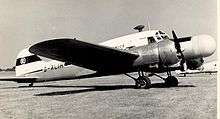
After the war, Ansons continued in production with Avro at Woodford. At this time, large amounts of the type were being produced for civilian use, where they were operated as light transports by a range of small charter airlines and as executive aircraft by large corporations. Countries which saw civilian operations with Ansons included the United Kingdom, Canada (Mk. V aircraft only), Australia and Denmark.
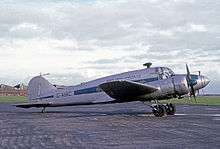
Railway Air Services operated Ansons on scheduled services from London's Croydon Airport via Manchester to Belfast (Nutts Corner) in 1946 and 1947. Sivewright Airways operated three Mk XIX aircraft from their Manchester Airport base on charter flights as far as Johannesburg and on scheduled flights to Ronaldsway Airport in the Isle of Man until 1951. Finglands Airways operated an ex-RAF Anson I on inclusive tour flights and on scheduled flights from Manchester Airport to Newquay Airport between 1949 and 1952. Kemps Aerial Surveys operated several Anson XIXs on survey work within the UK until their retirement in 1973.[25]
In 1948, India ordered 12 new Anson 18Cs for use by the Directorate of Civil Aviation as trainers and communications aircraft; these were delivered from Yeadon in the spring of 1949.[26]
Ansons continued to be manufactured by Avro at Woodford for the RAF until March 1952; the type was used as trainers and served in the role of Station communications aircraft until 1968.
The wooden wings of Ansons flying in Australia were found to fail at a high rate. The phenolic glue bonds would part, and it was speculated that the problem was due to the high humidity. In 1962, the Commonwealth Government decided to ground the majority of wooden-winged aircraft then in operation; amongst those aircraft affected, the Anson and De Havilland Mosquito were included. Of the Ansons, no such aircraft were re-registered as the government had mandated a test that essentially destroyed the wings, thus requiring the fitting of new wings. Most owners decided to voluntarily scrap their aircraft well before this time.
By the 21st century, the vast majority of Ansons had been retired from flying. However, a single Anson Mk.I, which had been originally manufactured during 1943, had been restored to airworthiness, having been refitted with later metal wings. On 18 July 2012, this restored aircraft returned to the air in Nelson, New Zealand.[27]
Accidents and incidents
_%22piggyback%22_in_a_paddock_near_Brocklesby_2.jpg)
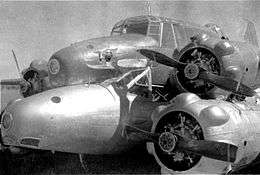
- On 28 April 1939, Anson A4-32 of No. 6 Squadron RAAF crashed near Riverstone, New South Wales on the return leg of an air navigation course, killing all four crew members.[28]
- On 18 December 1939, Anson 'N4887' of 1 Flying Training School crashed on the Richmond Golf Course shortly after take-off from the Richmond RAAF Base, killing all five crew members.[29]
- On 29 September 1940, Avro Ansons L9162 and N4876 of No. 2 Service Flying Training School RAAF collided in mid-air and became locked together in flight. A successful emergency landing was made at Brocklesby, New South Wales. L9162 became a ground instructional airframe, whilst N4876 was repaired and returned to service (see 1940 Brocklesby mid-air collision).
- On 8 November 1940 Avro Anson N9945 piloted by RAF Pilot Officer Frederick Phillip Fry struck a barrage balloon cable near Birmingham and crashed killing all 5 on board.
- On 28 January 1941 RAAF Avro Anson A4-5 left Parkes bound for Mascot on a medical evacuation flight. It approached Glenbrook and suffered a structural failure of the port wing crashing near the corner of Cliffton Ave and Lucasville Road killing all five on board.
- On 13 April 1941 Avro Anson N9857 of 19 Operational Training Unit from RAF Kinloss crashed on Beinn an Fhurain at an altitude of 2,300 feet (701 m) approximately 3 miles (5 km) east of Inchnadamph. At least 4 of the 6 aircrew survived the crash, but died of exposure in blizzard conditions. Their bodies are buried at the crash site.[30]
- On 9 October 1942, four Royal Australian Air Force (RAAF) airmen were killed when their Avro Anson aircraft crashed near Clackline, Western Australia (see Avro Anson Memorial).
- On 30 October 1942 an Avro Anson took off from Sidney airport on Vancouver Island, British Columbia, Canada, with Royal Canadian Air Force Sgt. William Baird and British air force Pilot Officer Charles Fox, Pilot Officer Anthony Lawrence and Sgt. Robert Luckock aboard. The aircraft crashed, killing all aboard, 50 kilometres (30 mi) from takeoff, on a remote mountainside near Port Renfrew. The wreckage and remains of the crew were found by loggers in October 2013 and recovered in May 2014.[31]
- On 7 December 1943 another piggy-back accident occurred when RCAF #18 SFTS Anson II JS193 came down on top of Anson II JS167 in the landing circuit at Gimli, Manitoba, the aircraft landed safely still entangled, and both were later repaired.[32]
- On 19 January 1944 RCAF #2 Training Command, Anson II #7164 landed on top of Anson II #8561 and again both landed safely but entangled. In this case #7164 was a write off, but #8561 was repaired.[33]
- On 13 February 1944 a USAAF 29(PR) Squadron AT-20 (Anson II) 43-8197 crashed on takeoff at Will Rogers Field, Oklahoma City, Oklahoma, 2Lt S.F. Jankowski killed, pilot V.N. Luber injured. The pilots had forgotten to remove the gust locks from the controls.[34] This was the only fatal accident involving a USAAF AT-20.
- On 19 December 1945, a Companhia Meridional de Transportes Avro Anson Mk. II registration PP-MTA crashed in the neighborhood of Itaipu, Niterói, Brazil killing all passengers and crew, including the pilot and owner of the airline, Álvaro Araújo.[35]
- On 14 December 1947 a Mark 1 AX505, ex VH-BBY, recently purchased by the Indonesian government and numbered RI-003, was being used to transport war equipment and medicine. It crashed in the sea between Malaya and Sumatra. The two crew were killed and were later appointed Indonesian National Heroes. There is a memorial to them with a sculpture of the aircraft.[36]
- On 11 June 1948, Avro XIX G-AGNI of Lancashire Aircraft Corporation ditched off Bradda Head, Isle of Man due to fuel exhaustion. The aircraft was operating a scheduled passenger flight from Squires Gate Airport, Blackpool to Ronaldsway Airport, Isle of Man via RAF Walney Island, Lancashire. All nine people on board were rescued by a trawler from Port Erin and the MV Silkthorn.[37]
Variants
The main Anson variant was the Mk I, of which 6,704 were built in Britain. The other variants were mainly distinguished by their powerplant with Canadian-built Ansons using local engines. To overcome steel shortages, the 1,051 Canadian-built Mk V Ansons featured a plywood fuselage.
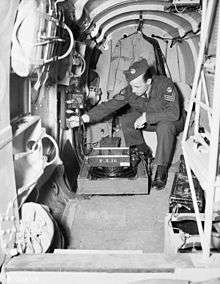
- Mk I
- 6,688 Mk Is were built. Powered by two 350 hp (261 kW) Armstrong Siddeley Cheetah IX or 395 hp (295 kW) XIX engines.
- Mk II
- 1,401 Mk IIs were built in Canada; powered by two 330 hp (246 kW) Jacobs L-6MB R-915 engines and fitted with hydraulic landing gear retraction rather than the manual system used on the Anson I.
- Mk III
- 432 Mk I aircraft converted in Canada to two 330 hp (250 kW) L-6MB R-915 engines.
- Mk IV
- One aircraft converted from a Mk I in Canada to two Wright Whirlwind engines.
- Mk V
- 1,069 Mk Vs were built in Canada for navigator training; powered by two 450 hp (340 kW) Pratt & Whitney Wasp Junior R-985 engines and given a new wood monocoque fuselage developed in the USA.
- Mk VI
- One aircraft was built in Canada for bombing and gunnery training; it was powered by two 450 hp (340 kW) Wasp Junior engines.
- Mk X
- 104 Anson Mk Is were converted into Mk Xs.
- Mk XI
- 90 Anson Mk Is were converted into Mk XIs.
- Mk XII
- 20 Anson Mk Is were converted into Mk XIIs, plus 221 new Mk XII aircraft built.
- Mk XIII
- Gunnery trainer powered by two Cheetah XI or XIX engines; never built.
- Mk XIV
- Gunnery trainer powered by two Cheetah XV engines; never built.
- Mk XVI
- Navigation trainer; never built.
- Mk XV
- Bombing trainer; never built.
- C 19
- 264 were built for the RAF; used as communications and transport aircraft.
- T 20
- Navigation trainer for the RAF, a variant of the Mk XIX to meet Air Ministry Specification T.24/46 for an overseas navigation trainer, one pilot two wireless operators (one trainee and one instructor) and five navigator positions (three trainees and two instructors). Used for bombing and navigation training in Southern Rhodesia, 60 built.
- T 21
- Navigation trainers for the RAF, a variant of the Mk XIX to meet Air Ministry Specification T.25/46 for a home navigation trainer, one pilot two wireless operators (one trainee and one instructor) and five navigator positions (three trainees and two instructors). A prototype was flown in May 1948, 252 were built.
- C.21
- Modification of T.21s for communications and transport duties.
- T 22
- Radio trainers for the RAF, a variant of the Mk XIX to meet Air Ministry Specification T.26/46, one pilot and four wireless operator stations (three for trainees and one for an instructor), a prototype was flown in June 1948, 54 built.
- Anson 18
- Developed from the Avro Nineteen; 12 aircraft were sold to the Royal Afghan Air Force for use as communications, police patrol and aerial survey aircraft.
- Anson 18C
- 13 aircraft were built for the Indian government; used for training civil aircrews.
- Avro Nineteen
- (Also known as the Anson XIX): Civil transport version; 56 aircraft were built in two series.
- AT-20
- United States military designation for Canadian-built Anson IIs used by the United States Army Air Forces, 50 built.
Operators
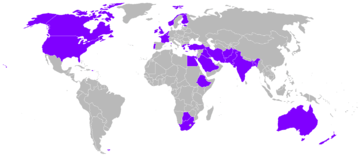

- Royal Afghan Air Force – 13 Anson 18 aircraft were delivered to the Royal Afghan Air Force from 1948 and retired by 1972

- At least one, LV-FBR, in use in 1960
.svg.png)
- Royal Australian Air Force – 1,028 Ansons were operated by the Royal Australian Air Force, retired in 1955
- Brain & Brown Airfreighters (one Anson until at least 1977)
- East-West Airlines, one preserved (non-flying), at Tamworth Airport
- Belgian Air Force (15 x Anson I, 2 x Anson 12s operated from 1946 to 1954)

- Companhia Meridional de Transportes (three Avro Anson Mk. IIs operated between 1945 and 1946)
.svg.png)
- Royal Canadian Air Force and Royal Canadian Navy Ansons were retired in 1952

- three Canadian-built Ansons were transported to Cuba, operated by ANSA-Aerolíneas del Norte S.A., a regional airline from 1947 until the mid-1950s

- Czechoslovakian Air Force three aircraft, in service from 1945 to 1948
.svg.png)
- Egyptian Air Force

- Estonian Air Force

- Ethiopian Air Force

- Finnish Air Force three Avro Anson Mk. Is purchased 1936 and used as training and liaison aircraft. One lost and another written-off in accidents, last flight in 1947.[38]

- French Air Force and Aeronavale
.svg.png)
- Hellenic Royal Air Force

- Royal Indian Air Force [23]

- Directorate of Civil Aviation
Indian Air Force .svg.png)
- Imperial Iranian Air Force
.svg.png)
- Royal Iraqi Air Force

- Irish Air Corps 9 Anson Mk1 delivered between 1937–39 and used for training/maritime patrol/transport. 3 Anson 19's delivered in 1946 for training/transport. Mk1's retired by 1947, 19's by 1962.

- Israeli Air Force

- Royal Netherlands Air Force and Dutch Naval Aviation Service

- Royal New Zealand Air Force

- Royal Norwegian Air Force

- Paraguayan Air Arm one Mk.V bought in Argentina in 1947.

- Portuguese Air Force
.svg.png)
- Royal Rhodesian Air Force

- Royal Saudi Air Force
.svg.png)
- South African Air Force
.svg.png)
- Southern Rhodesian Air Force

- Syrian Air Force

- Turkish Air Force

- Royal Air Force and Royal Navy
- Blue Line Airways
- British European Airways
- Finglands Airways
- Ministry of Civil Aviation
- Railway Air Services
- Sivewright Airways
- Starways
- Transair

- 50 Canadian built Ansons were delivered to the USAAF as the AT-20.
.svg.png)
- SFR Yugoslav Air Force
Surviving aircraft
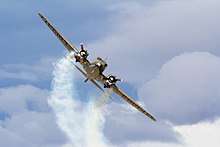
.jpg)
.jpg)
.jpg)
Australia
- On display
- R9883 – Anson I on static display at the Camden Museum of Aviation in Camden, New South Wales.[39]
- Unknown – Anson I on static display at the Aviation Heritage Museum at Bull Creek, Western Australia.[40]
- Stored or under restoration
- EF954 – Anson I under restoration at the South Australian Aviation Museum in Port Adelaide, South Australia. The restoration uses parts from AW965.[41]
- W2364 – Anson I under restoration at the Nhill Aviation Heritage Centre in Nhill, Victoria.[42][43]
Canada
- On display
- 886 – Anson II on static display at the Alberta Aviation Museum in Edmonton, Alberta.[44]
- 7135 – Anson II on static display at the Greenwood Military Aviation Museum in Greenwood, Nova Scotia.[45]
- 7481 – Anson II on static display at the Bomber Command Museum of Canada in Nanton, Alberta.[46]
- 12125 – Anson V on static display at the Commonwealth Air Training Plan Museum in Brandon, Manitoba.
- 12518 – Anson V on static display at the Canada Aviation and Space Museum in Ottawa, Ontario.[47]
- Composite – Anson II at The Hangar Flight Museum in Calgary, Alberta. It painted as RCAF 7401.[48]
- Composite – Anson II on static display at the British Columbia Aviation Museum in Sidney, British Columbia.[49] This airframe is K8786, restored using parts of FP846, as which it is painted.[50]
- Unknown – Anson I on static display at the Saskatchewan Western Development Museum in Moose Jaw, Saskatchewan.[51]
- Unknown – Anson II on static display at the National Air Force Museum of Canada in Trenton, Ontario [52]
- Stored or under restoration
- 12417 – Anson V under restoration to airworthy condition at the Canadian Warplane Heritage Museum in Hamilton, Ontario.[53]
- 12477/CF-HQZ Anson V stored at the Reynolds-Alberta Museum in Wetaskiwin, Alberta.[54]
Ireland
- On display
- 141 – Avro C.19 on static display at the Irish Air Corps Museum in Baldonnel, Dublin.[55]
Netherlands
- On display
New Zealand

- Airworthy
- MH120 – Anson I airworthy with R&R Aviation Limited in Wakefield, Tasman.[57][58]
- On display
- Composite – Anson I on static display at the Air Force Museum of New Zealand in Wigram, Canterbury. This airframe is a composite of several aircraft including the fuselage of NZ415, center section, mainplane, and tailplane of VL352, and various other parts from NZ410 and NZ422.[59]
United Kingdom
- Airworthy
- G-AHKX – Avro XIX Anson owned by BAe Systems (Heritage Flight) remains airworthy in 2017 and is based at the Shuttleworth Collection at Old Warden Aerodrome, Bedfordshire.[61]
- WD413 – Anson C.21, now privately owned and registered as G-VROE, previously operated by Classic Air Force at Coventry Airport.[62]
- On display
- N4877 – Anson I on static display at the Imperial War Museum Duxford in Duxford, Cambridgeshire.[63]
- W2068 – Anson I on static display at the Royal Air Force Museum London in London.[64][65]
- TX213 – Anson C.19 on static display at the North East Land, Sea and Air Museums in Sunderland, Tyne and Wear.[66]
- TX214 – Anson C.19 on static display at the Royal Air Force Museum Cosford in Cosford, Shropshire.[67][55]
- TX266 – Anson C.19 on static display whilst under restoration at Montrose Air Station Heritage Centre.[68]
- VL348 – Anson C.19 on static display at the Newark Air Museum in Newark, Nottinghamshire.[69]
- VL349 – Anson C.19 on static display at the Norfolk and Suffolk Aviation Museum in Flixton, Suffolk.[70]
- VM360 – Anson C.19 on static display at the National Museum of Flight in East Fortune, East Lothian.[71][72]
- Stored or under restoration
- AX246 – Anson I under restoration with Jet Art Aviation near Leeds, Yorkshire.[73]
- TX235 – Anson C.19 under restoration with the Classic Air Force near Coventry, West Midlands.[74]
- VM325 – Anson C.19 under restoration with the Carew Control Tower Group in Carew, Pembrokeshire.[75][76]
- VV901 – Anson T.21 under restoration to static display at the Yorkshire Air Museum in Elvington, West Yorkshire.[77]
Specifications (GR Mk I)
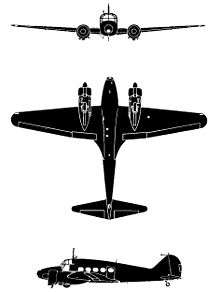
Data from The Hamlyn Concise Guide to British Aircraft of World War II,[9] Avro Aircraft since 1908[78]
General characteristics
- Crew: 3-4
- Length: 42 ft 3 in (12.88 m)
- Wingspan: 56 ft 6 in (17.22 m)
- Height: 13 ft 1 in (3.99 m)
- Wing area: 463 sq ft (43.0 m2)
- Empty weight: 5,375 lb (2,438 kg)
- Max takeoff weight: 8,000 lb (3,629 kg)
- Powerplant: 2 × Armstrong Siddeley Cheetah IX 7-cylinder air-cooled radial piston engines, 335 hp (250 kW) each
- Propellers: 2-bladed fixed-pitch propellers
Performance
- Maximum speed: 188 mph (303 km/h, 163 kn) at 7,000 ft (2,134 m)
- Cruise speed: 158 mph (254 km/h, 137 kn)
- Range: 660 mi (1,060 km, 570 nmi)
- Service ceiling: 19,000 ft (5,800 m)
- Rate of climb: 960 ft/min (4.9 m/s)
Armament
- Guns:
- 1 × .303 in (7.7 mm) machine gun in front fuselage
- 1 × .303 in (7.7 mm) Vickers K machine gun in dorsal turret
- Bombs:
- 360 lb (160 kg) of bombs
Notable planes
See also
Related development
Aircraft of comparable role, configuration and era
- Airspeed Oxford
- Cessna AT-17 Bobcat
- Focke-Wulf Fw 58
- Kyūshū Q1W Tokai
- Siebel Si 204
- Tachikawa Ki-54
Related lists
References
Notes
- Sturtivant Air Enthusiast Forty-two, pp. 38–39.
- Jackson 1990, pp. 321–322.
- Jackson 1990, pp. 322–323.
- Middleton Aeroplane Monthly April 1980, p. 187.
- Flight 30 January 1936, p. d.
- Middleton Aeroplane Monthly April 1980, pp. 187–188.
- Gunston, Bill. Classic World War II Aircraft Cutaways. London: Osprey, 1995. ISBN 1-85532-526-8.
- Flight 30 January 1936, p. c.
- Mondey 1994, p. 26.
- Jackson 1990, p. 323.
- Sturtivant Air Enthusiast Forty-two, p. 40.
- Flight 30 January 1936, pp. c–d.
- Flight 30 January 1936, p. 117.
- Jackson 1990, p. 326.
- Flight 30 January 1936, pp. 117–119.
- Sturtivant Air Enthusiast Forty-two, p. 39.
- Sturtivant Air Enthusiast Forty-two, pp. 43–44.
- Middleton Aeroplane Monthly April 1980, p. 191.
- March 1985, pp. 262–263.
- Franks 1983, pp. 125, 181.
- Cheesman 1946, pp. 66–67.
- Wilson 1994, p. 216.
- "No.1 Service Flying Training School (India)". Archived from the original on 3 August 2012.
- Canadian military Aircraft Serials and Photographs 1920–1968, J.A. Griffin, 1969
- Sturtivant, 1988, p. 294.
- Jackson 1990, pp. 338–339, 344–345.
- Neal, Tracy. "Restored-bomber-returns-to-the-skies." Nelson Mail, 18 July 2012. Retrieved: 19 July 2012.
- Dunn, Peter. "Crash of An Avro Anson near Riverstone, 28 April 1939". ozatwar.com. Retrieved 18 August 2016.
- Dunn, Peter. "Crash of an Avro Anson on Richmond Golf Course, 18 December 1939". ozatwar.com. Retrieved 18 August 2016.
- "Anson N9857 - Beinn an Fhurain". archieraf.co.uk. Retrieved 31 October 2019.
- "B.C. lumberjacks find bodies of Second World War airmen 72 years after Vancouver Island plane crash". National Post. 30 May 2014. Retrieved 1 June 2014.
- Air Force, Spring 1991, Summer 1991, Flypast May 1997, CAHS Journal Vol. 10, No. 4
- Air Force magazine, Winter, 1991
- Aviation Archaeological Investigation & Research, USAAF/USAF Accident Report Monthly List; A.J. Mireles forum.armyairforces.com
- Pereira, Aldo. Breve História da Aviação Comercial Brasileira (in Portuguese). Europa, (Rio de Janeiro), 1987, p. 290.
- Smith, Harro (9 April 2014). "Accident Avro Anson Mk I RI-003, 14 Dec 1947". aviation-safety.net. Aviation Safety Network. Retrieved 11 August 2018.
- Poole 1999, pp. 123–24.
- Heinonen and Valtonen 2010, pp. 100–101.
- "Anson 652-A Mk 1 R9883". The Camden Museum of Aviation. The Camden Museum of Aviation. Archived from the original on 1 June 2016. Retrieved 16 December 2016.
- "Avro Anson". Aviation Heritage Museum. Aviation Heritage Museum. Retrieved 16 December 2016.
- "Restorations". South Australian Aviation Museum. South Australian Aviation Museum. Retrieved 19 December 2016.
- "Restoration image library". Nhill Aviation Heritage Centre. Archived from the original on 16 February 2017. Retrieved 16 December 2016.
- "Restoring an Avro Anson – 2016 Update". Aces Flying High. 28 March 2016. Retrieved 16 December 2016.
- "Avro Anson II (1937)". Alberta Aviation Museum. Archived from the original on 17 December 2016. Retrieved 16 December 2016.
- "AVRO ANSON MKII". Greenwood Military Aviation Museum. GMAM. Retrieved 16 December 2016.
- "Avro Anson Mk II". Bomber Command Museum of Canada. Nanton Lancaster Society. Archived from the original on 28 August 2016. Retrieved 16 December 2016.
- "AVRO ANSON V". Canada Aviation and Space Museum. Canada Science and Technology Museums Corporation. Retrieved 16 December 2016.
- "AVRO 652 ANSON MK. II". The Hangar Flight Museum. The Hangar Flight Museum. Retrieved 16 December 2016.
- "The War Birds (1939–1945)". British Columbia Aviation Museum. Retrieved 16 December 2016.
- Macdonald, Ian M. "AVRO 652A ANSON 1, K8786, BRITISH COLUMBIA AVIATION MUSEUM". ABPic. Air-Britain. Retrieved 17 December 2016.
- "Aviation Gallery". Western Development Museum. Western Development Museum. Archived from the original on 18 August 2016. Retrieved 16 December 2016.
- "Anson – National Air Force Museum of Canada". Retrieved 8 March 2020.
- "Avro Anson Mk. V". Canadian Warplane Heritage Museum. Canadian Warplane Heritage Museum. Retrieved 16 December 2016.
- "Aviation". Reynolds Museum. Government of Alberta. Retrieved 1 December 2019.
- Simpson, Andrew (2012). "INDIVIDUAL HISTORY [TX214]" (PDF). Royal Air Force Museum. Royal Air Force Museum. Retrieved 17 December 2016.
- "Airframe Dossier – Avro Anson C.19, s/n VM352 RAF, c/n 7356". Aerial Visuals. AerialVisuals.ca. Retrieved 17 December 2016.
- "RR AVIATION". Top of the South Aviation Cluster. Top of the South Aviation Cluster. Retrieved 17 December 2016.
- "Airframe Dossier – Avro 652A Anson, s/n MH120 RAAF, c/n MH-120, c/r ZK-RRA". Aerial Visuals. AerialVisuals.ca. Retrieved 17 December 2016.
- "Featured Aircraft". Air Force Museum of New Zealand. Archived from the original on 20 December 2016. Retrieved 16 December 2016.
- Leeuw, Ruud. "Al Mahatta aviation museum – Sharjah, Feb.2010". Retrieved 17 December 2016.
- The Shuttleworth Collection – C19 Anson Retrieved: 4 December 2017
- CAA G-INFO Retrieved: 4 December 2017]
- "Avro Anson Mk 1". Imperial War Museums. Retrieved 16 December 2016.
- "Avro Anson 1". Royal Air Force Museum. Trustees of the Royal Air Force Museum. Retrieved 17 December 2016.
- Simpson, Andrew (2012). "INDIVIDUAL HISTORY [W2068]" (PDF). Royal Air Force Museum. Retrieved 17 December 2016.
- "Avro Anson C.19 (TX213/G-AWRS)". North East Aircraft Museum. North East Land, Sea and Air Museums. Retrieved 17 December 2016.
- "Avro Anson C.19". Royal Air Force Museum. Trustees of the Royal Air Force Museum. Retrieved 17 December 2016.
- "Anson to be restored". The Courier. Retrieved 3 May 2018.
- "Aircraft List". Newark Air Museum. Retrieved 17 December 2016.
- "OUR AIRCRAFT". Norfolk and Suffolk Aviation Museum. Retrieved 17 December 2016.
- "Avro Anson". National Museums Scotland. National Museums Scotland. Retrieved 17 December 2016.
- "Avro Anson G-APHV". National Museums Scotland. National Museums Scotland. Archived from the original on 21 December 2016. Retrieved 17 December 2016.
- Ellis 2016, p. 294.
- Ellis 2016, p. 275.
- Ellis 2016, p. 321.
- "Wings Over Carew" (PDF). GEM. Archived from the original (PDF) on 20 December 2016. Retrieved 17 December 2016.
- "Avro Anson T.21". The Yorkshire Air Museum. The Octane Factory. Retrieved 16 December 2016.
- Jackson 1990, p. 322.
Bibliography
- Cheesman, E. C. Brief Glory: the story of the ATA. Harborough Publishing, 1946.
- Donald, David and Jon Lake, eds. Encyclopedia of World Military Aircraft. London: AIRtime Publishing, 1996. ISBN 1-880588-24-2.
- Ellis, Ken. Wrecks & Relics – 25th Edition. Manchester, England:Crecy Publishing, 2016. ISBN 978 191080 9037
- Franks, Norman. The Air Battle of Dunkirk. London: William Kimber, 1983. ISBN 0-7183-0349-0.
- Gunston, Bill. Classic World War II Aircraft Cutaways. London: Osprey, 1995. ISBN 1-85532-526-8.
- Heinonen, Timo; Valtonen, Hannu (2010). Albatrossista Pilatukseen – Suomen sotilaslentokoneet 1917–2010 (in Finnish). Tikkakoski: Keski-Suomen ilmailumuseo. ISBN 978-952-99989-2-0.
- Jackson, A.J. Avro Aircraft since 1908, 2nd edition. London: Putnam Aeronautical Books, 1990. ISBN 0-85177-834-8.
- Hall, Alan W. Avro Anson Mks. 1–22 (Warpaint Series No. 53). Blechley, Buckinghamshire, UK: Warpaint Books Ltd., 2006.
- Hall, Alan W. and Eric Taylor. Avro Anson Marks I, III, IV & X. London: Almark Publishing Co. Ltd., 1972. ISBN 0-85524-064-4.
- Holmes, Harry. Avro Anson (Images of Aviation). London: Tempus Publishing Ltd., 2000. ISBN 0-7524-1738-X.
- March, Peter R. "Anson's 50th Birthday". Air Pictorial, Vol. 47, No. 7, July 1985. pp. 260–264.
- "Modernity for the R.A.F.: A Low-wing Cantilever Monoplane Goes Into Service — The Avro Anson, Equipped for Long-Range Over-water Reconnaissance: High Performance and a Comfortable Cabin". Flight, 30 January 1936, Vol. XXIX, No. 1414, pp. c–d, 117–119.
- Middleton, Don. "RAF Piston Trainers No. 8: Avro Anson". Aeroplane Monthly, April 1980, Vol. 8, No. 4. pp. 186–193. ISSN 0143-7240.
- Mondey, David. The Hamlyn Concise Guide to British Aircraft of World War II. London: Chancellor Press. 1994. ISBN 1-85152-668-4.
- Poole, Stephen. Rough Landing or Fatal Flight. Douglas, Isle of Mann, UK: Amulree Publications, 1999. ISBN 1-901508-03-X.
- Sturtivant, Ray C. The Anson File. Tonbridge, Kent, UK: Air-Britain (Historians) Ltd., 1988. ISBN 0-85130-156-8.
- Sturtivant, Ray. "Avro Anson: The chronicles of 'Faithful Annie'". Air Enthusiast, Forty-two, 1991. pp. 37–51. ISSN 0143-5450.
- Wilson, Stewart (1994). Military Aircraft of Australia. Weston Creek, Australia: Aerospace Publications. ISBN 1875671080.
External links
| Wikimedia Commons has media related to Avro Anson. |
- RNZAF Museum Anson page
- Anson from the IBCC Digital Archive at the University of Lincoln.